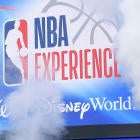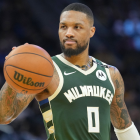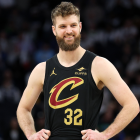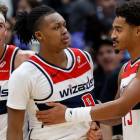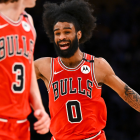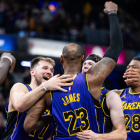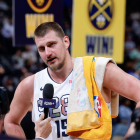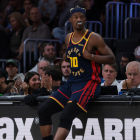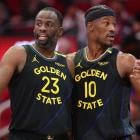The NBA finally admitted what many have long suspected on Saturday: it is indeed considering finishing the 2019-20 season at Disney World in Orlando, Florida. The plan makes plenty of sense on paper. Few other locations have Disney's combination of housing and athletic facilities. The fact that it is privately owned makes enforcing safety guidelines significantly easier. Disney is a corporate partner of the NBA's, as ESPN and ABC broadcast its games.
With the Disney plan slowly coming to fruition, we are starting to get a sense of how the NBA might resume its season. What we don't know is what the season will look like once it potentially restarts. The idea of bringing every team to a single location is totally unprecedented.
So while many of these details are still being determined, it's worth examining what a finished season at Disney might look like. How will the league schedule games? How will the broadcast experience change? What unforeseen side effects could arise out of this? Let's dig in and try to figure all of this out.
Selecting venues
ESPN's Wide World of Sports Complex has the theoretical capacity to hold up to 13 games or practices at a time. Here is how that capacity breaks down, according to Yahoo Sports' Keith Smith.
- The HP Field House is the complex's primary venue for basketball. It has a broadcast-capable court and hosts college basketball games annually.
- The Visa Center can be configured to include up to six courts at a time, and it is also broadcast-capable.
- The Arena can be configured to include up to six courts as well, and like the others, is ready for broadcast.
Now, obviously, the idea that 13 games would be held at once is absolutely ridiculous. The NBA would never hold even two games in the same building at the same time. If it became absolutely necessary, there are a number of other courts in Central Florida that could be used. The Amway Center, which hosts the Orlando Magic, and Addition Finance Arena, which hosts the University of Central Florida, could be used in a pinch. However, the early assumption should be that no more than three games would be played at a time.
However, during non-game days or even hours, the capacity to increase the number of courts in these arenas is critical for the sake of individual workouts. With hundreds of players sharing a single site and operating on wildly different schedules, Disney is going to need as many hoops as it can get to ensure that everyone can get enough shots up and perform any other necessary individual on-court work.
Organized team workouts are a bit more complicated. Teams might be skittish about practicing at the same time and in the same place as others, so some outside facilities would likely be necessary at least during the regular season and early postseason. Fortunately, if necessary, Orlando should be more than capable of accommodating. Magic and UCF facilities would likely be in play, but Florida's designation of professional sports as an essential industry suggests the possibility for governmental intervention if needed. If each team wanted to claim a local high school as its makeshift practice facility, then the state of Florida may be willing to work with them to make that possible. While this would pose added health risks, it should be noted that the current expectation is that the league will not enforce a full quarantine, instead allowing players to enter and exit a potential bubble. If this is the case, then teams potentially could exit as a group, which might actually be preferable. It is easier to enforce safety protocols within a team setting than it is for an individual with no supervision.
If not, Disney's versatility at least provides enough court space to adequately field games and practices. It might get a bit cramped early on, but once the playoff field begins to thin, ESPN's complex should be more than enough.
Scheduling games
In a normal season, the NBA aims for as many 7 p.m. local tips as possible. In addition to accommodating the television audience, the thinking is that it provides working fans enough time to get to the arena while also getting them home at a reasonable hour. The playoffs are a bit more complicated. As they are a national product, the league tries to cater to fans on the more densely populated East Coast by starting important games during its prime time window. The issue with doing so is that the fans attending those games in person out west have to rush to the arena after their workday ends. The Houston Rockets have notoriously struggled with fans arriving to games late because of these scheduling issues. Without fans in the arena, though, everything can be geared toward television.
Don't be surprised if that leads to earlier tip times on playoff games. With so many fans working from home now and therefore not commuting, the idea of starting Eastern Conference playoff games at 6 p.m. ET is not far-fetched. Doing so would allow Western Conference games to start between 8:30-9 p.m., similarly accommodating fans in the Pacific time zone, but allowing games to end early enough for eastern fans to stay awake and watch them to completion. The league has been struggling with that for years, thanks to teams like the Lakers and Warriors forcing games to be delayed until 10 p.m. or later.
The regular season, should it be completed in Orlando, could potentially look a good deal stranger. Day games should not be off the table for small-market teams. If March Madness can draw viewers at noon, then there's little reason to believe that the NBA can't as well. Games without playoff implications could be shunted into day slots to serve as appetizers for the more important ones that would be played at night. If three different courts are being used, the entire NBA could fit play in a single day using five different time slots. The NBA's goal in holding any sort of regular season would, first and foremost, be to reach 70 games in order to satisfy their local television deals. How they get there is ultimately not important as long as it is done expediently enough to get the playoffs going soon so as to avoid delaying next season any more than necessary.
Who teams would play in those regular-season games is another matter entirely. A number of suggestions have been made. Pelicans guard JJ Redick claimed on his podcast that the top six seeds are set and would only scrimmage, whereas seeds 7-12 would battle for the final two playoff spots. The Nets' Spencer Dinwiddie suggested a 30-team tournament format that would potentially make the trip to Orlando worthwhile for those in the lottery. The truth is that this is still being determined, but we can at least make a few guesses.
If the regular season is resumed at all, those television deals nearly guarantee that each team will get to 70 games. It would also be safe to assume that, to some degree, the standings would have to be disregarded. The No. 8 seed in both conferences lead the lottery field by at least 3.5 games, so shortened schedules wouldn't give any other teams reasonable chances to get into the postseason without some help from the league office. Some sort of play-in tournament that potentially favors teams currently in the postseason seems likely. Many of those games could be played concurrently in the interest of speed.
The broadcast experience
Basketball games will always fundamentally look like basketball games. How they sound, though, depends almost entirely on venue. Watch a pickup game and you'll hear trash-talk, the emotions of the game laid bare. Watch an NBA game and you'll hear three hours worth of manufactured noise designed to keep you engaged with what you're watching. The league is exploring ways to replicate that experience without fans. The Bundesliga soccer league in Germany has been piping in crowd noise. With your eyes closed, you can hardly tell fans aren't present.
87' Köln 0-2 Düsseldorf
— FOX Soccer (@FOXSoccer) May 24, 2020
90+1' @fckoeln_en 2-2 Düsseldorf
What a comeback from the Billy Goats! 🐐 pic.twitter.com/T6z5ja9vzR
There is a massive difference in doing this in German soccer and doing it in the NBA, though. These games are being played in empty stadiums, but stadiums nonetheless. They are massive and have acoustics designed for this sort of sound. While Disney's complex is impressive in virtually every other respect, none of its courts come on the sort of 20,000-seat stadiums teams are used to. Piping in something meant to approximate NBA fan noise in buildings so much smaller might prove a bit overbearing for players, so adjustments would have to be made from an acoustic perspective. Ideally, the experience should be as close to what is typically presented as possible, so it will be up to the TV networks' sound engineers to adjust typical crowd noise for that purpose.
As intriguing as silent games might seem, don't expect them to become a reality. Players are allowed to talk trash with near-impunity in real games because television cameras can't catch most of what they say. Teams nix most of the interesting audio to come out of players and coaches being mic'd up, so they are almost never caught saying things on the court that could get them in trouble with fans or advertisers. The union would never allow the league to remove those safeguards, and players shouldn't be forced to sensor themselves in the heat of battle. External audio is going to be provided during these games. It's just a matter of what that audio turns out to be.
The experience for announcers should remain largely unchanged. Most broadcasters have experience in calling games remotely, particularly those who have worked in radio. The voices of the playoffs should be familiar even if their surroundings are not.
Long-term ramifications
At no point in the history of North American professional sports has an entire major league been sequestered in a single location for an extended period of time. If history has taught us anything about what happens when NBA players spend time with one another outside of the regular context of the season, that can only mean one thing: tampering. Lots and lots of tampering.
Superteams tend to come from one of a few places. Team USA has created several of them. LeBron James, Dwyane Wade and Chris Bosh got to know each other at the 2008 Olympics. Kevin Durant, Stephen Curry and Andre Iguodala did so on the 2010 World Cup roster. All-Star Weekend is another favored tampering ground. Durant and Kyrie Irving conspicuously spent quite a bit of it together in 2019. College connections help as well. Wade and Jimmy Butler are both Marquette alums, and not only did the two play together in the NBA, but once Wade retired, Butler joined his former team in the Miami Heat. Karl-Anthony Towns and Devin Booker don't play together yet, but they have not been shy in stating their intention to reunite after jointly starring at Kentucky in 2015.
A Disney bubble essentially combines the circumstances of all three. It puts players in a position to regularly see players they might ordinarily meet in person only a few times a year. Sticking multiple teams in the same hotel, potentially without their families for some period of time, creates a dorm-like atmosphere. Players from different teams could theoretically share media obligations. How many chances do networks get to interview stars from several different teams at the same time? If individual workouts aren't policed, players could theoretically seek out like-minded stars they don't know particularly well to pick their brains on specific moves.
The broader point is that if NBA stars have managed to tamper from across the country for the past few decades, putting them all inside one bubble is only going to exacerbate that problem. Without security monitoring their every move, there's little to even stop executives from tampering with players within hotels. The seeds for superteams will be planted at Disney, and it's tempting to think of it strategically. Would teams prefer to keep a close eye on their players so as to help them avoid temptation, or will they unleash their stars as recruiters?
The answers will only reveal themselves over the next several years, but it would be naive to assume that an entire sport stranded in a single location will treat the situation honorably. There will be rule-breaking.
Will all of this affect the basketball?
The honest answer is that nobody knows. This situation is unprecedented, and it will surely reveal things about players we may never have otherwise learned. Perhaps some superstars need the energy of fans to play their best. Maybe others will thrive in the absence of distracting night-life.
Until teams actually take the floor in Orlando and start playing games, there is absolutely no telling how a single-site postseason will impact the product on the floor. If it happens, buckle up and enjoy the ride, because that's all any of us can do.
![[object Object] Logo](https://sportshub.cbsistatic.com/i/2020/04/22/e9ceb731-8b3f-4c60-98fe-090ab66a2997/screen-shot-2020-04-22-at-11-04-56-am.png)








